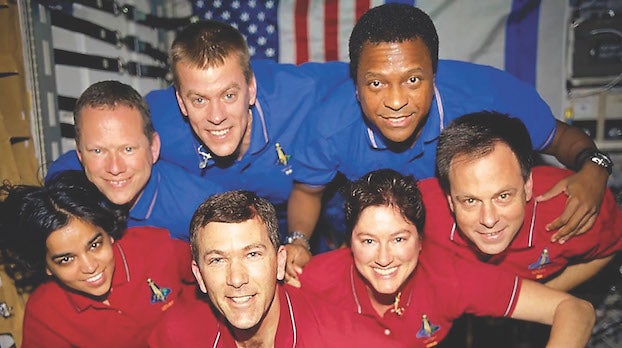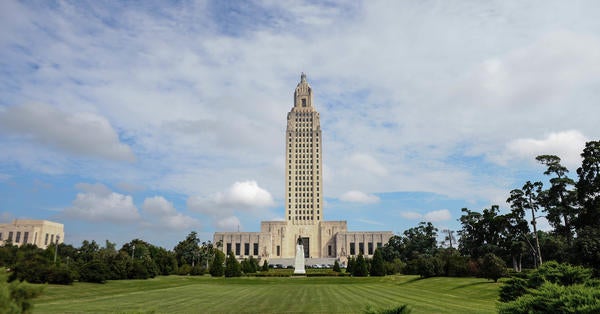Tragedy remembered: On Feb. 1, 2003, the Space Shuttle Columbia was destroyed during re-entry, killing all seven crew members onboard
Published 11:54 am Friday, January 27, 2023

- This undated photo from NASA released in June 2003 shows STS-107 crew members aboard the Space Shuttle Columbia. On Feb. 1, 2003, the seven crew members were lost as the Columbia fell apart over East Texas. This picture was on a roll of unprocessed film later recovered by searchers from the debris. From the left (bottom row), wearing red shirts to signify their shift’s color, are mission specialist Kalpana Chawla, commander, Rick D. Husband, mission commander Laurel B. Clark and Ilan Ramon, payload specialist. From the left (top row), wearing blue shirts, are mission specialist David M. Brown, pilot William C. McCool, pilot; and payload commander Michael P. Anderson. (Associated Press Archives)
NASA marked the 20th anniversary of the space shuttle Columbia catastrophe with somber ceremonies and remembrances during its annual tribute to fallen astronauts on Thursday.
Southwest Louisiana continues to mourn the tragedy, as well.
Columbia was destroyed during re-entry on Feb. 1, 2003, after a piece of fuel-tank foam came off and punctured the left wing during liftoff 16 days earlier. The shuttle broke apart over Texas, just 16 minutes from its planned Florida touchdown.
Columbia’s last crew included Israel’s first astronaut, Ilan Ramon, as well as commander Rick Husband, pilot William McCool, Michael Anderson, Kalpana Chawla, David Brown and Laurel Clark.
“The Columbia is lost,” then-President George W. Bush announced to America after he telephoning the families of the astronauts to console them.
“The same creator who names the stars also knows the names of the seven souls we mourn today,” Bush said, his eyes glistening. “The crew of the shuttle Columbia did not return safely to Earth, but we can pray they are safely home.”
It wasn’t the first tragedy to be experienced by the nation’s space program.
The shuttle Challenger exploded during liftoff on Jan. 28, 1986, killing all seven aboard — including schoolteacher Christa McAuliffe. The Apollo 1 launch pad fire claimed three astronauts’ lives on Jan. 27, 1967.
Because of the clustering of these three dates, NASA sets aside the last Thursday of every January to commemorate its fallen astronauts.
After the shuttle Columbia broke up during re-entry, it left a debris field that stretched west to east 380 miles from Eastland, Texas, to Alexandria and north-south 250 miles from Sulphur Springs, Texas, to Vernon Parish.
In Vernon, a one-foot piece of debris fell into a field near Burr Ferry on La. 111.
“It looks sort of like a cylinder and it missed hitting a home by about 75 yards,” then-Vernon Parish Sheriff’s Office spokesman Marvin Hilton told the American Press. “The family reported hearing the explosion, and their son was in the yard and saw the explosion and then saw something fall into the field.”
Hilton said the force of the impact caused the object to bury itself about three feet into the ground.
The witness dug up the debris.
“We began getting calls a little after 8 a.m. from residents in the western part of the parish about the explosion and falling debris,” he said. “We responded to the call in Burr Ferry and secured the area and the piece of debris.”
The witness had to be decontaminated after handling the debris.
Two days after the crash, a swatch of fabric emblazoned with the Israeli air force flag, a notebook page of technical jargon and a scrap of paper with McCool’s name on it was discovered by a Leesville woman.
Vernon Sheriff Sam Craft told the American Press the woman thought the papers — some wrinkled, slightly scorched but otherwise intact, others in scraps — were run-of-the-mill litter.
“The woman just looked out in her yard and saw paper on her yard,” Craft said. “The papers included a scrap with McCool’s name and another scrap with mission number STS107.”
Other debris later collected in Vernon included three large pieces of metal, masses of hairlike strands that were later ruled to be insulation, and pieces of material that Craft said was similar to Kevlar, a synthetic material used to make bulletproof body armor.
In Sabine Parish, material splashed into Toledo Bend.
Then-Chief Deputy Travis Bennett told the American Press that fishermen saw and heard debris splashing into the 181,600-acre lake and its Louisiana woodline.
Elbie Bradley, 69, who was fishing on the reservoir at the time of the crash, said he “heard the piece coming down through the air. It sounded like it was fluttering.”
Then-Lt. William Davis of the Louisiana State Police told the American Press 85 pieces of shuttle debris were ultimately found in Louisiana. Debris was found in 19 parishes and ranged from sheets of paper to insulation, computer circuitry and human bones.
In north Louisiana, debris was found in Caddo, Bossier and Webster parishes, and one piece was found as far south as Lafourche Parish, near the Houma airport.
The pieces range in size from roughly 8 feet long to those about the size of a silver dollar, Davis said.
Like NASA’s earlier tragedies, Columbia’s loss was avoidable, said former shuttle commander Bob Cabana, now NASA’s associate administrator.
“When we look back, why do we have to keep repeating the same hard lessons?” he said during Thursday’s ceremony in Cape Canaveral, Fla. “I don’t ever want to have to go through another Columbia.”
•
The Associated Press contributed to this report.





